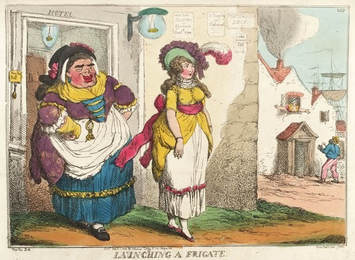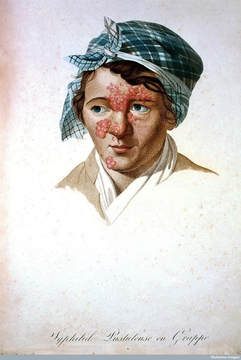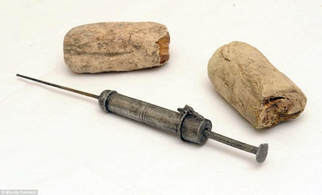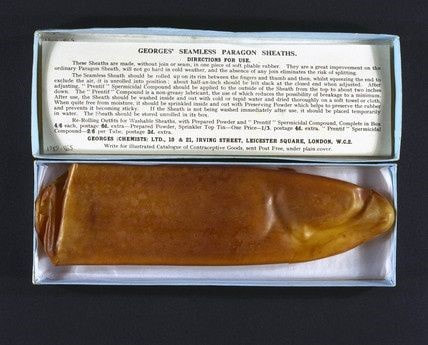'A Dying Syphilization: Syphilis, The Scourge of the Victorian Sex Worker' by Therese Oneill9/7/2017 Therese Oneill is a historian and humorist, and the New York Times Bestselling author of Unmentionable: The Victorian Lady’s Guide to Sex, Marriage and Manners. Meet her at https://writerthereseoneill.com You can follow her at @ThereseNOneill [Hi friends, Therese here. I just wanted to let you know I’m mostly going to use “she” in this piece when I reference sex workers. Cuz most of the history I write and research is about women, so it’s my best pronoun…but please, consider it a placeholder. Once we get a proper non-gendered or pan-gendered pronoun that is neither terrifyingly dehumanizing (“it”) nor lip-biting, eye-squinting baffling to even the most well-meaning cisgendered suburbanite (ey, ve, xe,) I will use that. Because I AM that well-meaning suburbanite. Staring at you while our kids play in the park fountain together, trying with an earnest heart to understand how come if you’ve got boobs and a vagina and you’re attracted to other boobs and vaginas but you say you aren’t “just gay” because sexual identify is fluid and…then I begin to lose the thread so all I can do is offer helpfully “Oh! Like Boys Don’t Cry! You’re Hilary Swank! Yeah?” and you give a deep sigh and start to try and explain but and then just shake your head and answer flatly, “Yeah. Yeah I’m Hilary Swank,” because you’re very tired and I’m not the most ignorant or close minded person you’ve had to deal with this week, there might be hope for me. Plus our kids seem to be getting along and you’re willing to make some sacrifices for your daughter to make a new pal. So bear with me, friends, and you’ll have my gratitude. ]  The life of a 19th century sex worker wasn't all silk and diamonds The life of a 19th century sex worker wasn't all silk and diamonds There are some hazards of occupation that a sex worker will undertake no matter what era or place she lived. She may always struggle for respect, she will always need to be vigilant of her personal safety, and prevention of disease is always a consideration. Those rules apply to today’s sex worker. Yesteryear’s sex worker, however, the real Whores of Yore, had an entire catalogue of hazards modernity has taken off our hands. One of the greatest was a microscopic, highly contagious, squiggly little bacteria called syphilis. A Raw Deal Today, syphilis is one of many sexually transmitted diseases that all sexually active people need to be fortified against, and it is treatable with antibiotics. So we don’t worry so much. Put the average person on the spot and they probably wouldn’t be able to tell you how it was different from gonorrhoea or herpes. But if you truly were a Whore of Yore, specifically Victorian Era, the spectre of syphilis would haunt your dreams. And that’s saying something because the 19th century was all around awful, and there were a lot of spectres competing for nightmare face-time. A Victorian “prostitute” (I know that’s not a happy word, but it is the one the nicest of people would have used at the time) was not quite considered human. Now, mind you, the richest lady in town was not quite considered human either; she was a lady, apt to menstrual derangements and uterine revolts.  "Launching a frigate" by Thomas Rowlandson (1809) "Launching a frigate" by Thomas Rowlandson (1809) But a woman who would copulate for money with rapscallions and miscreants…heaven help us. Of course, not all sex work was trading the use of your vagina for money: then as now there were specialty houses and services available for all sorts of kinks. And the women who had the skills to land positions as dancers, dominatrix, and other non-direct-contact sex work would have been considerably safer from disease. The ones who did exchange money for the use of their vaginas, however, were plentiful. Actually, society was so structured that most all women lived through a variation of that trade. For instance, I myself have been exchanging sex (as well as scintillating conversation and occasional child-bearing) for money, shelter, and the opportunity to piggyback on some terrific medical insurance for the past 18 years. It’s just been with the same guy and if tries to dump me I get half his stuff. We call that marriage, then and now. But the Ye Olde Nymph of the Pave had hard luck, any way you cut it. Her chances of plying her trade on her own terms in a clean, safe upper-class brothel or her own respectable home were…well…almost entirely a fictitious scenario. (Unless you had the luck to become a wealthy man’s long term mistress, which social scientists of the day still classed as prostitution). Sex work was not always a choice in Victoriana. It was rare, in a society built against women in general, for a female sex worker to have complete freedom and control of her work and her life, even though, for many, prostitution offered more freedom than a traditional “proper life.” It paid more than working in the laundry or taking in sewing, but it wasn’t without drawbacks, no matter how she set herself up. Newspapers, pennydreadfuls and court records are full of madams and pimps who kept almost all her earnings for room and board, rather than keeping her safe, unless the client was willing to pay enough to cover her time off work while her bruises healed. The poorest of the poor, (the ‘bunters’, the ‘hedge whores’) such as Elizabeth Gaskell’s Esther, tended toward alcoholism (drug addiction if possible, opiates were very much available but often out of her price range) to counter daily miseries and allow her to paste on the smile that earned her daily bread. Since society was so strict, her violation of its rules was very hard to hide, causing her to be ostracized. Without reliable birth control she had numerous pregnancies or fatal abortions. And if she was not young and pretty, she didn’t get a brothel. A street whore’s life could be a terror. She was at the mercy of the freezing snow and stinking urban summers, her money was stolen from her or never given in the first place, and she wasn’t allowed in places decent folk went unless she could successfully “pass” for respectable. Also, seriously…Jack the Ripper and all the psychos that didn’t get famous. Men preyed on easy targets then same as now. There were exceptions of course, as Henry Mayhew describes 'the Happy Prostitute'. 'and there is such a thing, is either the thoroughly hardened, clever infidel, who knows how to command men and use them for her own purposes; who is in the best set both of men and women; who frequents the night-houses in London, and who in the end seldom fails to marry well; or the quiet woman who is kept by the man she loves, and who she feels is fond of her; who has had a provision made for her to guard her against want, and the caprice of her paramour'. London Labour and the London Poor by Henry Mayhew, 1862 So if our Whore of Yore managed to navigate all the other pitfalls of life in the 19th century, disease was the one most likely to finally clip the wings of a Victorian “Soiled Dove”. And of those diseases, (well, honestly tuberculosis and cholera and smallpox and…like a really bad splinter from a broom handle that turned septic were all pretty reasonable options, but that applied to everyone) syphilis was the monster. Incurable, slowly fatal, flesh-rotting, mind-stealing horrifying syphilis.  Image from Wellcome Collection Image from Wellcome Collection Whatever You Think Syphilis Does, Add Ten Pounds More Nightmare to It. In late stages, syphilis was often confused with leprosy. That’s the one where in Bible times you had to lurch your way through the village, pieces of your body rotting off you as you stumbled forth, ringing a bell and screaming “UNCLEAN! UNCLEAN!” through your ravaged throat. Syphilis ate away the hard bone of your skull, the soft tissue of your nose, it covered your body in pox that hardened, layer on layer, obscuring whatever body part lay beneath with swollen tumors of weeping lesions. And it literally rotted your brain, wasting away nerve connections and bringing on a slow and all-consuming dementia. For 19th century vivid color illustrations of the disease, (first check and make sure you’ve got some extra bits of soul that you’ll not mind never getting back because you cannot unsee these pictures), click here, here, and here. The disease is also transmissible from mother to baby, but I can’t bear to lead you to those pictures. And I can bear a lot. But why did the disease become such an epidemic in the 19th Century?  Hi. Would you happen to have any affordable sex available? We’d ask non-professionals, but it’s still the Victorian Age so most women aren’t putting out until forced by marriage contract.” Hi. Would you happen to have any affordable sex available? We’d ask non-professionals, but it’s still the Victorian Age so most women aren’t putting out until forced by marriage contract.” How Machines Gave Everyone Syphilis. Kinda. Syphilis has been around for centuries. It was named after a character in a 15th century poem who was struck with a contagious, horrifying disease, and it might have existed before that. English speakers called it “The French Disease” since it skyrocketed among soldiers whenever France was involved in a war. (The French called it “The English Disease, Russians called it “The Polish Disease”….basically “Our Current Enemy’s Penis Disease”). But in the 1800s, syphilis left the battlements and settled in at home. It went like this. The Industrial Revolution. Machines that could do human labour 1000 times faster and cheaper got invented. And even though a mechanical loom could make a hundred bolts of linen a day, you still needed humans to assemble the loom and run it. In fact more humans than ever before. Humans to clean, load, reset the machines. Humans to transport the products the machines made to all the new stores and hotels and restaurants that were popping up. Humans to work inside those shops and hotels. Suddenly, western society wasn’t farm-based anymore. Or even trade-skill based. For the first time in history, young people could leave the stinking, back-breaking life of farm labor and move to the stinking, back-breaking life offered in the city. It was rough going, but it was at least a little bit more exciting than staring at (and relying upon) a cow’s swinging teat-sack for the rest of your life. So millions moved to cities to work in a shop or a factory or a hospitality industry. Safe Sex Meant Carrying a Knife in Your Corset Syphilis couldn’t be truly cured before antibiotics were invented mid-20th century. Could it be prevented? Condoms existed in the 19th century, and they could help prevent the spread of the disease. But, y’know, technically plutonium existed in the 19th century and could be used to power all those machines everyone was relying on. But who wanted to go through the hassle of making use of either? First of all, or much of the 19th century in America, condoms were illegal, due to the crusading of one uptight idealist who thought he could purify an already prudish nation by making sex scary, named Anthony Comstock. What some saw as protection, he saw as an invitation to a civilization-wide orgy of lust and debauchery. He got The Comstock Act, prohibiting the use of mail to distribute prophylactics or information about prophylactics, passed in the 1870s. The mail of course being one of only two forms of long distance communication at the time, the other being yelling. People who were determined enough got around the law, importing condoms and other forms of birth control (if not disease control) from Europe and Asia (illegally). That’s how condoms got one of their oddest old fashioned nicknames, “French Letters”…a corruption of “envelope” as in, condoms arrive in an envelope from France, then envelope the male member so that it might in turn be enveloped by the female member. As far as wacky walrus-mustache nicknames go, you’ve also probably heard condoms called “sheepskins.” Well, good news. They didn’t actually skin sheep to make them. They used sheep’s intestines, thoroughly cleaned and rinsed, cut to size and tied off with a ribbon. To see a fascinating step by step recreation, visit The Sally Pointer and Gareth Riseborough blog. So maybe tying a piece of dead sheep onto your penis was a mood killer. Unless you used a particularly handsome ribbon, or soaked the intestine in pleasant perfumes and lotions, which many home recipes urged. There were also condoms made from linen, since they weren’t concerned at the time with fluid transmission. (Germs? What the hell are germs? You’re telling me tiny invisible monsters live in fluids and can kill me? Sure, whatever. I’ll be in the lookout for itty bitty Frankensteins crawling about trying to smash my labia with their tiny angry fists) It was more about protecting the penis from the dirty, dirty vagina. And there simply was nothing finer and cleaner than linen. Then, (thanks to ease of production resulting from the…say it together class…Industrial Revolution…yes, cuz irony) in the middle of the 19th century, affordable reusable rubber condoms became available, but, they were…just horrible. Just practically wrapping tire tread around your penis. People preferred the animal intestines. Ladies of the Evening would purchase and keep their own condoms, usually just one, giving it a quick rinse after use. But they best not have much competition in their work -place, because the girl willing to bareback it would be the one to attract more customers. Men also would often carry their own, preferring the inconvenience to the seeping genital warts. All in all condoms didn’t do much to stem the brutal tide of Victorian syphilis. Especially since it was commonly believed that if a person didn’t show actual genital warts, they were not infected. And indoor lighting was pretty terrible back then. Of course the biggest way syphilis was transmitted, according to Men of Learning, was filthy women who couldn’t be bothered to give their vaginas a proper flush. 2If, in general, women were more cleanly and careful of themselves, the venereal disease would be far less common. How many women have received the contagious matter, and transmitted it, without becoming infected themselves!" (Italics original to manuscript) - 'A Practical Treatise on Venereal Diseases' by P. H. Ricord, MD, 1842. They were infected of course, and a quick rinse in whatever corrosive, home-made birth-control/disease-buster potion the poor woman had concocted (the main ingredients of which ranged from borax, paprika, vinegar, whiskey, to coffee) wouldn’t have don’t much. But we have to blame someone for this epidemic, and it’s hardly fair to blame the poor men who are biologically compelled to seek out comfortable orifices to rest their penises in. They’re just following Nature’s imperative, after all.  616th century mercury urethra syringe and bandages. They hadn't changed much by the 1800s. 616th century mercury urethra syringe and bandages. They hadn't changed much by the 1800s. Treatments Since we had centuries to try and battle syphilis, people came up with some really creative, horrifying and ineffective ideas, bless them. Rubbing the infected organs, or even injecting them, with poisons was one of the most popular. Particularly mercury, a steady application of which (often inserted directly into the urethra with a syringe) would in fact lessen the effects of syphilis, or at least make them seem less important as you slowly succumbed to death from mercury poisoning. They also, at various times in the 19th century, rubbed chlorides, platinum and gold against the infected sores. For a while, since syphilis presents early as pox, and other pox diseases responded to inoculation, there came a brief fashion of “syphilization.” That is, taking scraping from a syphilitic chancre and stabbing it into test cases to see if immunity or recovery would result. It didn’t, but many supporters of the practice insisted it did, reporting dozens of the cured. Which is really odd because that’s now how syphilis works and those people could not have been cured that way. It quickly fell out of favour. It was very late in the 19th century when arsenic took the lead in the fight against syphilis. Different arsenic based concoctions did prove effective in treating syphilis. Which was useful in WWI, when America was one of the only countries to send its soldiers off to war without condoms as part of their standard kit. Because yes, we expected our boys to fight, perhaps steal a bit from the odd family farm if they needed to, and most certainly there will be a few occasions to rip another man’s stomach open with a rusty bayonet… but fornication? Heaven forfend. Not surprisingly, syphilis was one of the largest causes of visits to the medical tents during The Great War. Although it was a reported practice for an infected man to spread his disease to his fellow soldiers by applying discharge from his penis to a stick or swab that the other man could then infect his own member with. Because any manner of venereal disease was preferable to huddling in a freezing trench waiting to be ordered at any moment to charge blindly into German gunfire. In 1943, penicillin changed the world, all but eradicated syphilis in the developed world, and turned a festering scourge into an irritating inconvenience. Bad Romance
It's easy to romanticise the olden-days whore, with her lace and silks and velvety laughter. Even the pornography of the day can led us to believe it was a grand old time being had by beautiful people, sexually liberated a century before the rest of us caught up. But that was seldom, if ever, the whole story. Whores of Yore are beautiful, but we would be doing them a dishonour to forget their fears, abuses and struggles. Syphilis was just one of many dark, terrifying corners our Fallen Sisters had to brave. Sources The Wellcome Museum Journal of Military and Veterans' Health University of Kansas Medical Center
3 Comments
|
Sex History ContentsIf you would like to submit an article, please fill out a submission on the Contact page Archives
September 2020
|

 RSS Feed
RSS Feed